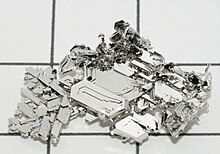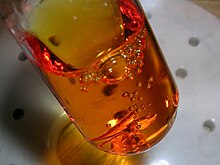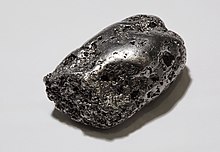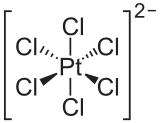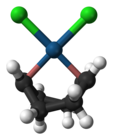Spherical platinum nanoparticles can be made with sizes between about 2 and 100 nanometres (nm), depending on reaction conditions. Platinum nanoparticles are suspended in the colloidal solution of brownish-red or black color. Nanoparticles come in wide variety of shapes including spheres, rods, cubes, and tetrahedra.
Platinum nanoparticles are the subject of substantial research, with potential applications in a wide variety of areas. These include catalysis, medicine, and the synthesis of novel materials with unique properties.
Synthesis
Platinum nanoparticles are typically synthesized either by the reduction of platinum ion precursors in solution with a stabilizing or capping agent to form colloidal nanoparticles, or by the impregnation and reduction of platinum ion precursors in a micro-porous support such as alumina.
Some common examples of platinum precursors include potassium hexachloroplatinate (K2PtCl6) or platinous chloride (PtCl2) Different combinations of precursors, such as ruthenium chloride (RuCl3) and chloroplatinic acid (H2PtCl6), have been used to synthesize mixed-metal nanoparticles Some common examples of reducing agents include hydrogen gas (H2), sodium borohydride (NaBH4) and ethylene glycol (C2H6O2), although other alcohols and plant-derived compounds have also been used.
As the platinum metal precursor is reduced to neutral platinum metal (Pt0), the reaction mixture becomes supersaturated with platinum metal and the Pt0 begins to precipitate in the form of nanoscale particles. A capping agent or stabilizing agent such as sodium polyacrylic acid or sodium citrate is often used to stabilize the nanoparticle surfaces, and prevents the aggregation and coalescence of the nanoparticles.
The size of nanoparticles synthesized colloidally may be
controlled by changing the platinum precursor, the ratio of capping
agent to precursor, and/or the reaction temperature.
The size of the nanoparticles can also be controlled with small
deviation by using a stepwise seed-mediated growth procedure as outlined
by Bigall et al. (2008).
The size of nanoparticles synthesized onto a substrate such as alumina
depends on various parameters such as the pore size of the support.
Platinum nanoparticles can also be synthesized by decomposing Pt2(dba)3 (dba = dibenzylideneacetone) under a CO or H2 atmosphere, in the presence of a capping agent. The size and shape distributions of the resulting nanoparticles depend on the solvent,
the reaction atmosphere, the types of capping agents and their relative
concentrations, the specific platinum ion precursor, as well at the
temperature of the system and reaction time.
Shape and size control
Electron micrographs of Ostwald ripening in Pd nanoparticles dissolved in formaldehyde at 6 (a), 24 (b), 48 (c) and 72 hours (d). The small Pd particles are being consumed as the larger ones grow bigger.
Ramirez et al. reported the influence of ligand and solvent effects on the size and shape of platinum nanoparticles. Platinum nanoparticle seeds were prepared by the decomposition of Pt2(dba)3 in tetrahydrofuran (THF) under carbon monoxide
(CO). These conditions produced Pt nanoparticles with weakly bound THF
and CO ligands and an approximate diameter on 1.2 nm. Hexadecylamine
(HDA) was added to the purified reaction mixture and allowed to displace
the THF and CO ligands over the course of approximately seven days,
producing monodispersed spherical crystalline Pt nanoparticles with an
average diameter of 2.1 nm. After the seven-day period, an elongation of
the Pt nanoparticles occurred. When the same procedure was followed
using a stronger capping agent such as triphenyl phosphine or octanethiol, the nanoparticles remained spherical, suggesting that the HDA ligand affects particle shape.
Oleylamine, oleic acid and platinum acetylacetonate [Pt(acac)2]
are also used in the synthesis of size/shape controlled platinum
nanoparticles. Research showed that alkylamine can coordinate with Pt2+ ion and form tetrakis(amine)platinate precursor and replace the original acac− ligand in Pt(acac)2, and oleic acid can further exchange with acac− and tune the formation kinetics of platinum nanoparticles.
When Pt2(dba)3 was decomposed in THF under hydrogen gas in the presence HDA, the reaction took much longer, and formed nanowires with diameters between 1.5 and 2 nm. Decomposition of Pt2(dba)3 under hydrogen gas in toluene
yielded the formation of nanowires with 2–3 nm diameter independent of
HDA concentration. The length of these nanowires was found to be
inversely proportional to the concentration of HDA present in solution.
When these nanowire syntheses were repeated using reduced concentrations
of Pt2(dba)3, there was little effect on the size, length or distribution of the nanowires formed.
Platinum nanoparticles of controlled shape and size have also
been accessed through varying the ratio of polymer capping agent
concentration to precursor concentration. Reductive colloidal syntheses
as such have yielded tetrahedral, cubic, irregular-prismatic, icosahedral, and cubo-octahedral
nanoparticles, whose dispersity is also dependent on the concentration
ratio of capping agent to precursor, and which may be applicable to
catalysis.
The precise mechanism of shape-controlled colloidal synthesis is not
yet known; however, it is known that the relative growth rate of crystal facets within the growing nanostructure determines its final shape. Polyol syntheses of platinum nanoparticles, in which chloroplatinic acid is reduced to PtCl42− and Pt0 by ethylene glycol, have also been a means to shape-controlled fabrication. Addition of varying amounts of sodium nitrate
to these reactions was shown to yield tetrahedra and octahedra at high
concentration ratios of sodium nitrate to chloroplatinic acid. Spectroscopic studies suggest that nitrate is reduced to nitrite by PtCl42−
early in this reaction, and that the nitrite may then coordinate both
Pt(II) and Pt(IV), greatly slowing the polyol reduction and altering the
growth rates of distinct crystal facets within the nanoparticles,
ultimately yielding morphological differentiation.
Green synthesis
An
ecologically-friendly synthesis of platinum nanoparticles from
chloroplatinic acid was achieved through the use of a leaf extract of Diospyros kaki
as a reducing agent. Nanoparticles synthesized as such were spherical
with an average diameter ranging from 212 nm depending on reaction
temperature and concentration of leaf extract used. Spectroscopic analysis suggests that this reaction is not enzyme-mediated and proceeds instead through plant-derived reductive small molecules. Another eco-friendly synthesis from chloroplatinic acid was reported using leaf extract from Ocimum sanctum and tulsi as reducing agents. Spectroscopic analysis suggested that ascorbic acid, gallic acid, various terpenes, and certain amino acids were active in the reduction. Particles synthesized as such were shown through scanning electron microscopy to consist in aggregates with irregular shape. It has been shown that tea extracts with high polyphenol content may be used both as reducing agents and capping agents for platinum nanoparticle synthesis.
Properties
The
chemical and physical properties of platinum nanoparticles (NP) make
them applicable for a wide variety of research applications. Extensive
experimentation has been done to create new species of platinum NPs, and
study their properties. Platinum NP applications include electronics,
optics, catalysts, and enzyme immobilization.
Catalytic properties
Platinum NPs are used as catalysts for proton exchange membrane fuel cell (PEMFC), for industrial synthesis of nitric acid, reduction of exhaust gases from vehicles and as catalytic nucleating agents for synthesis of magnetic NPs. NPs can act as catalysts in homogeneous colloidal solution or as gas-phase catalysts while supported on solid state material. The catalytic reactivity of the NP is dependent on the shape, size and morphology of the particle.
One type of platinum NPs that have been researched on are colloidal platinum NPs. Monometallic and bimetallic
colloids have been used as catalysts in a wide range of organic
chemistry, including, oxidation of carbon monoxide in aqueous solutions,
hydrogenation of alkenes in organic or biphasic solutions and hydrosilylation of olefins in organic solutions. Collodial platinum NPs protected by Poly(N-isopropylacrylamide)
were synthesised and their catalytic properties measured. It was
determined that they were more active in solution and inactive when
phase separated due to its solubility being inversely proportional to
temperature.
Optical properties
Platinum
NPs exhibit fascinating optical properties. Being a free electron metal
NP like silver and gold, its linear optical response is mainly
controlled by the surface plasmon resonance. Surface plasmon resonance occurs when the electrons in the metal surface are subject to an electromagnetic field that exerts a force on the electrons and cause them to displace from their original positions. The nuclei then exert a restoring force
that results in oscillation of the electrons, which increase in
strength when frequency of oscillations is in resonance with the
incident electromagnetic wave.
The SPR of platinum nanoparticles is found in the ultraviolet
range (215 nm), unlike the other noble metal nanoparticles which display
SPR in the visible range Experiments were done and the spectra obtained
are similar for most platinum particles regardless of size. However,
there is an exception. Platinum NPs synthesized via citrate reduction do
not have a surface plasmon resonance peak around 215 nm. Through
experimentation, the resonance peak only showed slight variations with
the change of size and synthetic method (while maintaining the same
shape), with the exception of those nanoparticles synthesized by citrate
reduction, which did not exhibit and SPR peak in this region..
Through the control of percent composition of 2–5 nm platinum nanoparticles on SiO2,
Zhang et al. modeled distinct absorption peaks attributed to platinum
in the visible range, distinct from the conventional SPR absorption.
This research attributed these absorption features to the generation and
transfer of hot electrons from the platinum nanoparticles to the
semiconductive material. The addition of small platinum nanoparticles on semiconductors such as TiO2 increases the photocatalytic oxidation activity under visible light irradiation.
These concepts suggest the possible role of platinum nanoparticles in
the development of solar energy conversion using metal nanoparticles. By
changing the size, shape and environment of metal nanoparticles, their
optical properties can be used for electrontic, catalytic, sensing, and
photovoltaic applications.
Applications
Fuel cells application
Hydrogen fuel cells
Among
the precious metals, platinum is the most active toward the hydrogen
oxidation reaction that occurs at the anode in hydrogen fuel cells. In
order to meet cost reductions of this magnitude, the Pt catalyst loading
must be decreased. Two strategies have been investigated for reducing
the Pt loading: the binary and ternary Pt-based alloyed nanomaterials
and the dispersion of Pt-based nanomaterials onto high surface area
substrates.
Methanol fuel cells
The methanol oxidation reaction occurs at the anode in direct methanol fuel cells
(DMFCs). Platinum is the most promising candidate among pure metals for
application in DMFCs. Platinum has the highest activity toward the
dissociative adsorption of methanol. However, pure Pt surfaces are
poisoned by carbon monoxide,
a byproduct of methanol oxidation. Researchers have focused on
dispersing nanostructured catalysts on high surface area supporting
materials and the development of Pt-based nanomaterials with high
electrocatalytic activity toward MOR to overcome the poisoning effect of
CO.
Electrochemical oxidation of formic acid
Formic acid
is another attractive fuel for use in PEM-based fuel cells. The
dehydration pathway produces adsorbed carbon monoxide. A number of
binary Pt-based nanomaterial electrocatalysts have been investigated for
enhanced electrocatalytic activity toward formic acid oxidation.
Modifying conductivity of zinc oxide materials
Platinum NPs can be used to dope zinc oxide
(ZnO) materials to improve their conductivity. ZnO has several
characteristics that allow it to be used in several novel devices such
as development of light-emitting assemblies and solar cells. However, because ZnO is of slightly lower conductivity than metal and indium tin oxide (ITO), it can be doped and hybridized with metal NPs like platinum to improve its conductivity. A method to do so would be to synthesize ZnO NPs using methanol reduction and incorporate at 0.25 at.% platinum NPs.
This boosts the electrical properties of ZnO films while preserving its
transmittance for application in transparent conducting oxides.
Glucose detection applications
Enzymatic glucose sensors have drawbacks that originate from the nature of the enzyme.
Nonenzymatic glucose sensors with Pt-based electrocatalysts offer
several advantages, including high stability and ease of fabrication.
Many novel Pt and binary Pt-based nanomaterials have been developed to
overcome the challenges of glucose oxidation on Pt surfaces, such as low
selectivity, poor sensitivity, and poisoning from interfering species.
Other applications
Platinum catalysts are alternatives of automotive catalytic converters, carbon monoxide gas sensors, petroleum refining,
hydrogen production, and anticancer drugs. These applications utilize
platinum nanomaterials due to their catalytic ability to oxidize CO and
NOx, dehydrogenate hydrocarbons, and electrolyze water and their ability
to inhibit the division of living cells.
Biological interactions
The
increased reactivity of nanoparticles is one of their most useful
properties and is leveraged in fields such as catalysis, consumer
products, and energy storage. However, this high reactivity also means
that a nanoparticle in a biological environment may have unintended
impacts. For example, many nanoparticles such as silver, copper, and
ceria interact with cells to produce reactive oxygen species or ROS which can cause premature cell death through apoptosis.
Determining the toxicity of a specific nanoparticle requires knowledge
of the particle’s chemical composition, shape, size and is a field that
is growing alongside advances in nanoparticle research.
Determining the impact of a nanoparticle on a living system is not straightforward. A multitude of in vivo and in vitro studies must be done to fully characterize reactivity. In vivo studies often use whole organisms such as mice or zebrafish
to infer the interaction of the nanoparticle on a healthy human body.
In vitro studies look at how nanoparticles interact with specific cell
colonies, typically of human origin. Both types of experiments are
needed for a complete understanding of nanoparticle toxicity, especially
human toxicity, since no one model has complete human relevance.
Drug delivery
A topic of research within the field of nanoparticles is how to use these small particles for drug delivery.
Depending on particle properties, nanoparticle may move throughout the
human body are promising as site-specific vehicles for the transport of
medicine. Current research using platinum nanoparticles in drug delivery
uses platinum-based carries to move antitumor medicine. In one study,
platinum nanoparticles of diameter 58.3 nm were used to transport an
anticancer drug to human colon carcinoma cells, HT-29. Uptake of the nanoparticles by the cell involves compartmentalization of the nanoparticles within lysosomes. The high acidity environment enables leaching
of platinum ions from the nanoparticle, which the researchers
identified as causing the increased effectiveness of the drug. In
another study, a Pt nanoparticle of diameter 140 nm was encapsulated
within a PEG nanoparticle to move an antitumor drug, Cisplatin, within a prostate cancer cell (LNCaP/PC3) population.
Use of platinum in drug delivery hinges on its ability to not interact
in a harmful manner in healthy portions of the body while also being
able to release its contents when in the correct environment.
Toxicology
Toxicity stemming from platinum nanoparticles can take multiple forms. One possible interaction is cytotoxicity or the ability of the nanoparticle to cause cell death. A nanoparticle can also interact with the cell’s DNA or genome to cause genotoxicity.
These effects are seen in different levels of gene expression measured
through protein levels. Last is the developmental toxicity that can
occur as an organism grows. Developmental toxicity looks at the impact
the nanoparticle has on the growth of an organism from an embryonic
stage to a later set point. Most nanotoxicology research is done on
cyto- and genotoxicity as both can easily be done in a cell culture lab.
Platinum nanoparticles have the potential to be toxic to living
cells. In one case, 2 nm platinum nanoparticles were exposed to two
different types of algae in order to understand how these nanoparticles interact with a living system.
In both species of algae tested, the platinum nanoparticles inhibited
growth, induced small amounts of membrane damage, and created a large
amount of oxidative stress. In another study, researcher tested the effects of differently sized platinum nanoparticles on primary human keratinocytes.
The authors tested 5.8 and 57.0 nm Pt nanoparticles. The 57 nm
nanoparticles had some hazardous effects including decreased cell
metabolism, but the effect of the smaller nanoparticles was much more
damaging. The 5.8 nm nanoparticles exhibited a more deleterious effect
on the DNA stability of the primary keratincoytes than did the larger
nanoparticles. The damage to the DNA was measured for individual cells
using single-gel electrophoresis via the comet assay.
Researchers have also compared the toxicity of Pt nanoparticles
to other commonly used metallic nanoparticles. In one study, the authors
compared the impact of different nanoparticle compositions on the red blood cells
found in the human bloodstream. The study showed that 5–10 nm platinum
nanoparticles and 20–35 nm gold nanoparticles have very little effect on
the red blood cells. In the same study it was found that 5–30 nm silver
nanoparticles caused membrane damage, detrimental morphological
variation, and haemagglutination to the red blood cells.
In a recent paper published in Nanotoxicology, the authors found
that between silver (Ag-NP, d = 5–35 nm), gold (Au-NP, d = 15–35 nm),
and Pt (Pt-NP, d = 3–10 nm) nanoparticles, the Pt nanoparticles were the
second most toxic in developing zebrafish embryos, behind only the Ag-NPs.
However, this work did not examine the size dependence of the
nanoparticles on their toxicity or biocompatibility. Size-dependent
toxicity was determined by researchers at the National Sun Yat – Sen
University in Kaohsiung, Taiwan. This group’s work showed that the
toxicity of platinum nanoparticles in bacterial cells is strongly
dependent on nanoparticle size and shape/morphology.
Their conclusions were based on two major observations. First, the
authors found that platinum nanoparticles with spherical morphologies
and sizes less than 3 nm showed biologically toxic properties; measured
in terms of mortality, hatching delay, phenotypic defects and metal
accumulation.
While those nanoparticles with alternative shapes—such as cuboidal,
oval, or floral—and sizes of 5–18 nm showed biocompatibility and no
biologically toxic properties.
Secondly, out of the three varieties of platinum nanoparticles which
exhibited biocompatibility, two showed an increase in bacterial cell
growth.
The paper introduces many hypotheses for why these observations
were made, but based on other works and basic knowledge of bacterial
cell membranes, the reasoning behind the size dependent toxicity
observation seems to be twofold. One: The smaller, spherically shaped
nanoparticles are able to pass through cell membranes simply due to
their reduced size, as well as their shape-compatibility with the
typically spherical pores of most cell membranes.
Although this hypothesis needs to be further supported by future work,
the authors did cite another paper which tracked the respiratory intake
of platinum nanoparticles. This group found that 10 µm platinum
nanoparticles are absorbed by the mucus of the bronchi and trachea, and
can travel no further through the respiratory tract. However, 2.5 µm particles showed an ability to pass through this mucus layer, and reach much deeper into the respiratory tract.
Also the larger, uniquely shaped nanoparticles are too large to pass
through the pores of the cell membrane, and/or have shapes which are
incompatible with the more spherically shaped pores of the cellular
membrane.
In regards to the observation that the two largest platinum
nanoparticles (6–8 nm oval, and 16–18 nm floral) actually increase
bacterial cell growth, the explanation could originate in the findings
of other works which have shown that platinum nanoparticles have
demonstrated significant antioxidative capacity.
However, it must be noted that in order for these antioxidative
properties to be exploited, the platinum nanoparticles must first enter
the cells, so perhaps there is another explanation for this observation
of increased bacterial cell growth.
Most studies so far have been size based using an in vivo mouse
model. In one study, researchers compared the effects of sun 1 nm and
15 nm platinum nanoparticles on mice.
The 15 mg/kg dose of sub 1 nm platinum nanoparticles were found to
cause liver damage while the larger particles had no effect. A similar
study using a singular injection as an exposure source of platinum
nanoparticles into the mouse model found necrosis of tubular epithelial
cells for particles under 1 nm, but no effect with those particles of
8 nm.
These in vivo studies show a trend that the toxicity of the platinum
nanoparticles is size dependent, most likely due to the ability of the
nanoparticle to get into a high impactful region within the body. A
complete study analyzing the effect of varying sized platinum
nanoparticles used both in vivo and in vitro models is used to gain a
better understanding what impact these nanoparticles could have.
Using mice as a model, they found retention of the platinum
nanoparticles by the respiratory tract of the mouse. This was
accompanied by a minor to mild inflammation of the surrounding lung
tissue. However, their in vitro tests using human and lung epithelial cells found no cytotoxic or oxidative stress effects caused by the platinum nanoparticles despite clear evidence of cellular uptake.

